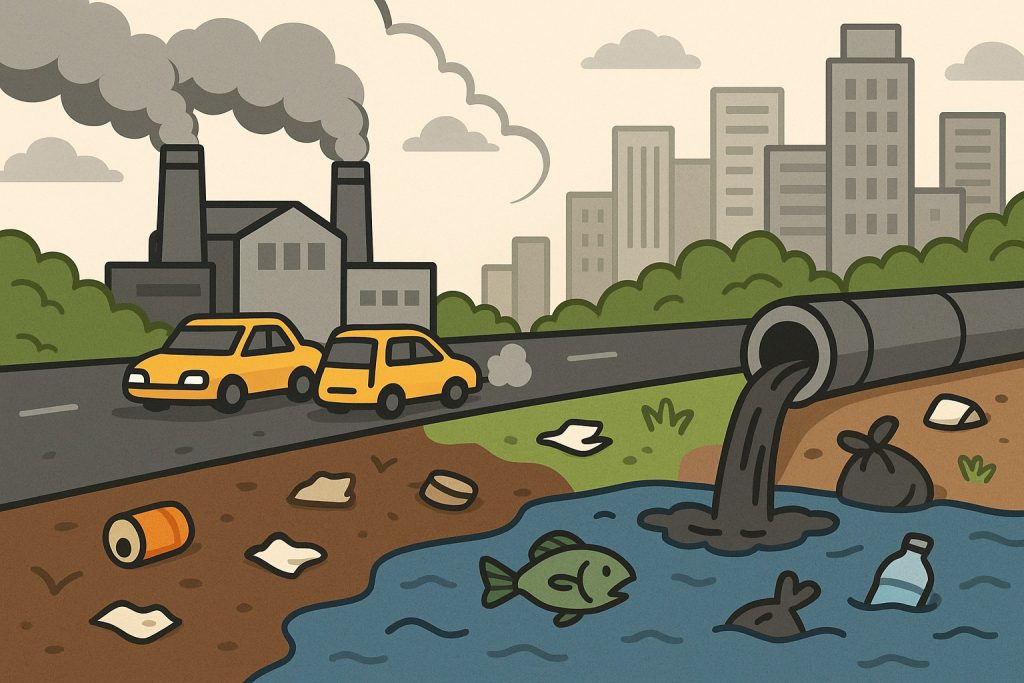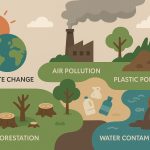Modern life offers countless conveniences — from cars and factories to plastic packaging and electronics. Yet these very advancements come with a heavy price: environmental pollution. Across the air, water, and land, human activity is degrading ecosystems, endangering wildlife, and threatening human health. This article examines the main types of pollution caused by humans, their consequences, and what can be done to reduce them.
What Is Environmental Pollution?
Environmental pollution is the introduction of harmful substances or energy into the environment, leading to damage in natural systems. These pollutants can be solid, liquid, gaseous, or even in the form of noise, heat, or radiation. Most pollution today is directly linked to industrial, agricultural, and urban activities.
Major Types of Human-Caused Pollution
1. Air Pollution
- Caused by vehicle emissions, factory smoke, burning fossil fuels, and wildfires
- Common pollutants include carbon monoxide (CO), nitrogen oxides (NOx), sulfur dioxide (SO₂), and particulate matter (PM2.5)
- Leads to respiratory diseases, heart problems, and contributes to global warming
2. Water Pollution
- Results from dumping industrial waste, agricultural runoff, sewage, and plastic into rivers, lakes, and oceans
- Affects marine ecosystems, poisons drinking water, and spreads disease
- Fertilizer runoff causes algal blooms, which suffocate aquatic life
3. Soil Pollution
- Comes from the use of pesticides, landfill waste, heavy metals, and industrial chemicals
- Reduces soil fertility and contaminates crops
- Harms organisms in the ground and enters the food chain
4. Plastic Pollution
- Plastic takes hundreds of years to decompose
- Microplastics are now found in oceans, drinking water, and even the human body
- Marine animals often mistake plastic for food, leading to injury or death
5. Noise Pollution
- Generated by urban traffic, construction, aircraft, and industrial machinery
- Disrupts wildlife behavior and can cause stress, insomnia, and hearing problems in humans
6. Light Pollution
- Excessive artificial lighting in cities affects nocturnal animals and human sleep cycles
- Disorients birds and insects, disrupting migration and reproduction
Causes of Increased Pollution
- Overpopulation and urban expansion
- Industrialization without adequate environmental controls
- Consumer culture and throwaway habits
- Weak environmental laws or lack of enforcement
- Dependence on fossil fuels for energy and transport
Consequences for the Planet and Humanity
- Climate change driven by greenhouse gas emissions
- Biodiversity loss as species lose habitat or die from pollutants
- Health crises due to contaminated air, water, and food
- Economic damage from healthcare costs, crop loss, and disaster response
- Social inequality, as poorer communities often suffer the worst pollution
What Can Be Done?
By Governments and Industry
- Enforce environmental regulations and pollution limits
- Shift to clean energy sources (solar, wind, hydro)
- Promote sustainable agriculture and waste treatment
- Encourage eco-friendly product design and circular economy
By Individuals
- Reduce single-use plastic consumption
- Walk, cycle, or use public transport
- Choose eco-labeled products and support green companies
- Recycle and dispose of hazardous waste properly
- Raise awareness and support environmental initiatives
Conclusion
Pollution is not an unavoidable side effect of progress — it is the result of decisions we can choose to change. With the right policies, technologies, and public action, we can reduce human impact on the planet. A cleaner environment means better health, more resilient ecosystems, and a safer future for all living beings.
Glossary
- Particulate matter (PM2.5) – tiny particles in the air that can enter the lungs and bloodstream
- Runoff – water that flows from land into waterways, often carrying pollutants
- Microplastics – tiny plastic fragments that result from breakdown of larger plastic items
- Greenhouse gases – gases that trap heat in the atmosphere, contributing to global warming
- Circular economy – an economic system that emphasizes reuse, recycling, and waste reduction


